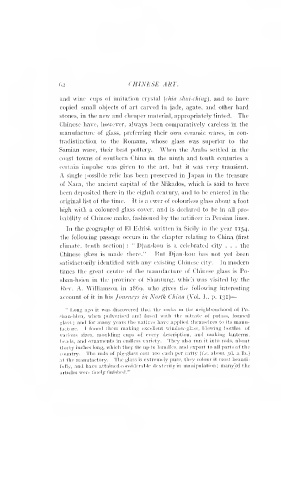Page 226 - Chinese Art, Vol II By Stephen W. Bushell
P. 226
62 CHINESE ART. —
and wine cups of imitation crystal (chia shui-ching), and to have
copied small objects of art carved in jade, agate, and other hard
stones, in the new and cheaper material, appropriately tinted. The
Chinese have, however, always been comparatively careless in the
manufacture of glass, preferring their own ceramic wares, in con-
tradistinction to the Romans, whose glass was superior to the
Samian ware, their best pottery. When the Arabs settled in the
coast towns of southern China in the ninth and tenth centuries a
certain impulse was given to the art, but it was very transient.
A single possible relic has been preserved in Japan in the treasure
of Nara, the ancient capital of the Mikados, which is said to have
been deposited there in the eighth century, and to be entered in the
original list of the time. It is a ewer of colourless glass about a foot
high with a coloured glass cover, and is declared to be in all pro-
bability of Chinese make, fashioned by the artificer in Persian lines.
In the geography of El Edrisi, written in Sicily in the year 1154,
the following passage occurs in the chapter relating to China (first
"
chmate, tenth section) : Djan-kou is a celebrated city . . . the
Chinese glass is made there." But Djan-kou has not yet been
satisfactorily identified with any existing Chinese city. In modern
times the great centre of the manufacture of Chinese glass is Po-
shan-hsien in the province of Shantung, which was visited by the
Rev. A. WilHamson in 1869, who gives the following interesting
account of it in his Journeys in North China (Vol. I., p. 131)
" Long ago it was discovered tliat the rocks in the neighbourhood of Po-
shan-hien, when pulverised and fused with the nitrate of potass, formed
glass ; and for many years the natives have applied themselves to its manu-
facture. I found them making excellent window-glass, blowing bottles of
various sizes, moulding cups of every description, and making lanterns,
beads, and ornaments in endless variety. They also run it into rods, about
thirty inches long, which they tie up in bundles, and export to all parts of the
country. The rods of pig-glass cost 100 cash per catty (i.e. about 3d. a lb.)
at the manufactory. The glass is extremely pure, they colour it most beauti-
fully, and have attained considerable dexterity in manipulation ; many'of the
articles were finely finished."

